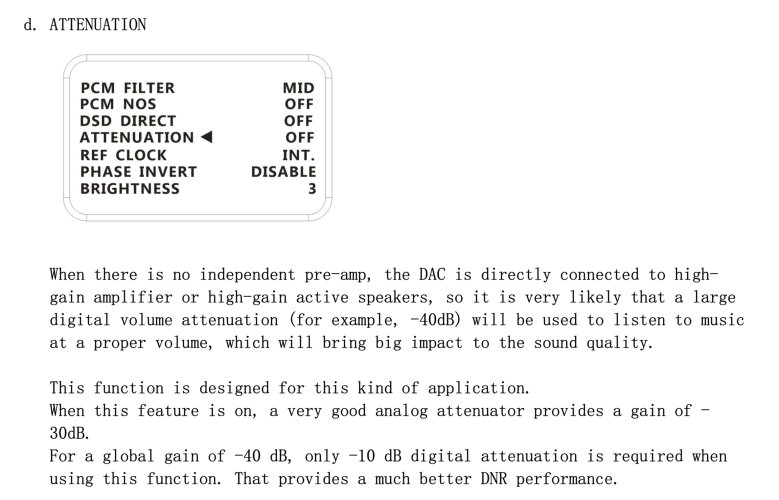Deleeh
Headphoneus Supremus
Hello,
I will give you a good example of what Attenuator does.
I use my very good rollable tube amplifier.
As a small crash course there are tubes that have a high Mu Factor as well as a low Mu Factor.
The Mu factor is seen as a gain value, which means for drivers and output tubes.
Here you can mix between a low driver tube like 6SN7 which has a mu factor of 20 mu, a 6SL7 has a higher value of 70 mu which is very high.
The same applies to output tubes, typical tubes are EL84, EL3N, EL12 and others, KT66/88, EL34, 6L6 are more in the middle, while a 6AS7G tube has a relatively low u value.
So now I choose a combination of say 6SN7 with KT66/88 Attenuator is OFF, because otherwise I have to extend the potentiometer very far and the overall gain is quite low from the tube amplifier when set to ON.
If it were switched on, I would bring the potentiometer to its maximum limit and the volume would remain predominantly low.
This can be good or bad.
Now I use a combination that is stronger in the Mu factor,6SL7 with EL3N.
Here it makes sense to switch on the attenuator, because you hardly touch the potentiometer and it gets loud directly and you have hardly any control over it.
Furthermore, this can lead to clipping, i.e. crosstalk between the speakers and headphones.
Which is also bad over time.
That's why I switch Attenuator to ON here, to be able to control the whole thing better.
I have just done this with the 6SL7 and EL3N combination and the result is that the amplifier gets half the power, I have more control over the potentiometer when I put my Atrium open on now, I am at about 12 o'clock position rather than 11 o'clock, which is then almost really loud when the attenuator is OFF.
This is also good because the channel imbalance from the potentiometer is out of the window as the potentiometer likes to be turned up from zero.
Since Attenuator is ON, I move the whole thing back a bit and still have the full dynamic range and all these things.
On SS amplifier you have to try something that is better for you.
Either leave the amp at maximum gain and Attenuator OFF and all is well, or just try switching Attenuator on first and see what happens.
If the amplifier has a gain switch, I would work with the latter but set the attenuator to OFF.
But you should only go higher with the gain switch when the potentiometer is at zero on the amplifier.
It is impossible to predict what will happen if the potentiometer is not at zero.
You should pay attention to 2 things when adjusting the gain, the first is that you have enough control over the potentiometer and that it does not clip when you turn it up further.
And secondly, always set the potentiometer to zero when you want to switch.
Listening to and evaluating the sound comes last.
One last thing about what FIXED means.
Here the output voltage to the amplifier always remains the same regardless of whether XLR or RCA.
FIXED always remains active if NOS or DSD is active or both, which means no control.
If you now switch off NOS or DSD or both must be OFF, you can use the remote control to adjust the volume again in minus DB.
However, you may lose dynamics and such things here and have to turn up the potentiometer further on the amplifier to compensate.
That would be the last thing. It would be the last thing I would use if the gainswitch doesn't give a deliverable result.
Then I would work with it, but the price is that there is no DSD neither NOS.
I will give you a good example of what Attenuator does.
I use my very good rollable tube amplifier.
As a small crash course there are tubes that have a high Mu Factor as well as a low Mu Factor.
The Mu factor is seen as a gain value, which means for drivers and output tubes.
Here you can mix between a low driver tube like 6SN7 which has a mu factor of 20 mu, a 6SL7 has a higher value of 70 mu which is very high.
The same applies to output tubes, typical tubes are EL84, EL3N, EL12 and others, KT66/88, EL34, 6L6 are more in the middle, while a 6AS7G tube has a relatively low u value.
So now I choose a combination of say 6SN7 with KT66/88 Attenuator is OFF, because otherwise I have to extend the potentiometer very far and the overall gain is quite low from the tube amplifier when set to ON.
If it were switched on, I would bring the potentiometer to its maximum limit and the volume would remain predominantly low.
This can be good or bad.
Now I use a combination that is stronger in the Mu factor,6SL7 with EL3N.
Here it makes sense to switch on the attenuator, because you hardly touch the potentiometer and it gets loud directly and you have hardly any control over it.
Furthermore, this can lead to clipping, i.e. crosstalk between the speakers and headphones.
Which is also bad over time.
That's why I switch Attenuator to ON here, to be able to control the whole thing better.
I have just done this with the 6SL7 and EL3N combination and the result is that the amplifier gets half the power, I have more control over the potentiometer when I put my Atrium open on now, I am at about 12 o'clock position rather than 11 o'clock, which is then almost really loud when the attenuator is OFF.
This is also good because the channel imbalance from the potentiometer is out of the window as the potentiometer likes to be turned up from zero.
Since Attenuator is ON, I move the whole thing back a bit and still have the full dynamic range and all these things.
On SS amplifier you have to try something that is better for you.
Either leave the amp at maximum gain and Attenuator OFF and all is well, or just try switching Attenuator on first and see what happens.
If the amplifier has a gain switch, I would work with the latter but set the attenuator to OFF.
But you should only go higher with the gain switch when the potentiometer is at zero on the amplifier.
It is impossible to predict what will happen if the potentiometer is not at zero.
You should pay attention to 2 things when adjusting the gain, the first is that you have enough control over the potentiometer and that it does not clip when you turn it up further.
And secondly, always set the potentiometer to zero when you want to switch.
Listening to and evaluating the sound comes last.
One last thing about what FIXED means.
Here the output voltage to the amplifier always remains the same regardless of whether XLR or RCA.
FIXED always remains active if NOS or DSD is active or both, which means no control.
If you now switch off NOS or DSD or both must be OFF, you can use the remote control to adjust the volume again in minus DB.
However, you may lose dynamics and such things here and have to turn up the potentiometer further on the amplifier to compensate.
That would be the last thing. It would be the last thing I would use if the gainswitch doesn't give a deliverable result.
Then I would work with it, but the price is that there is no DSD neither NOS.





















